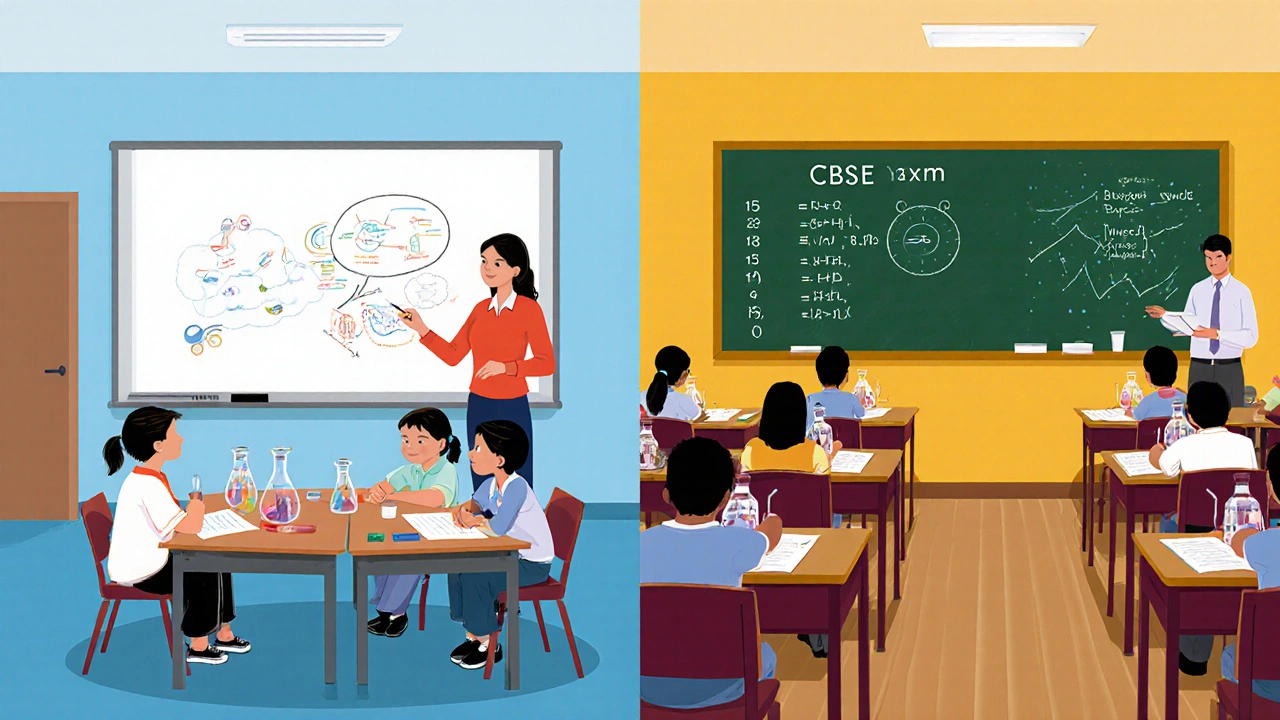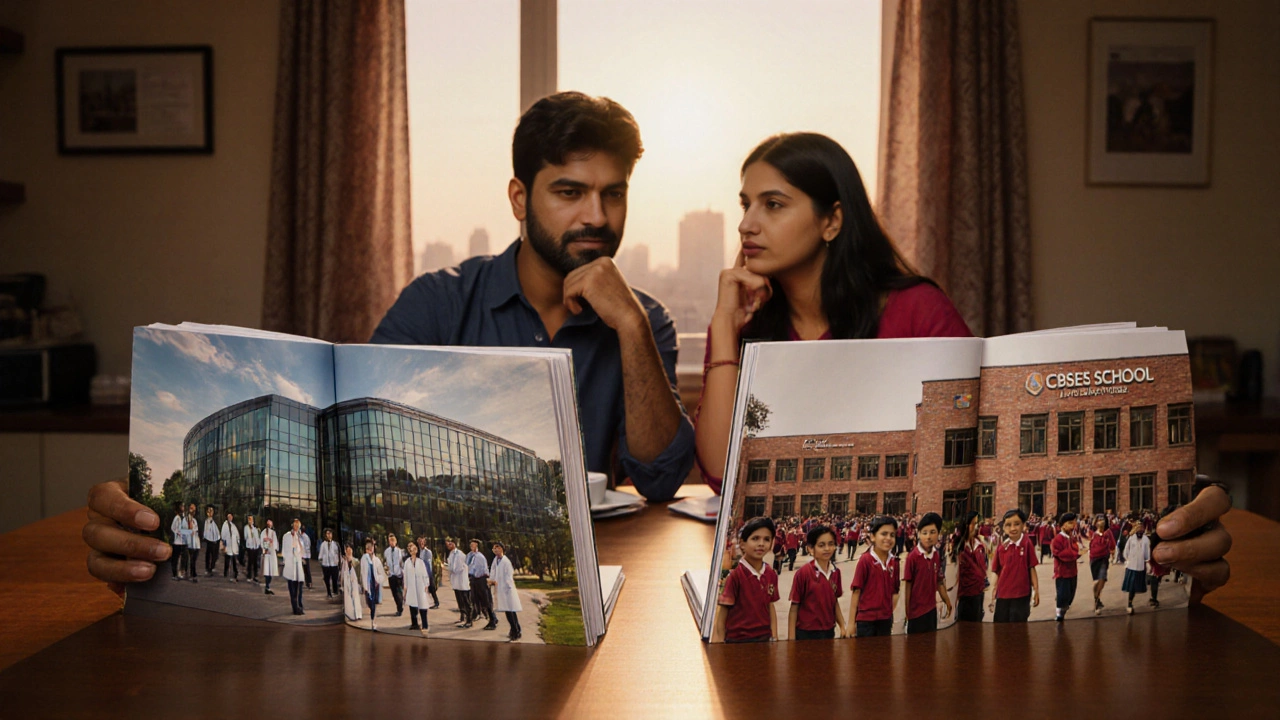Choosing a school board feels a bit like picking a career path for a teenager - the decision sticks around for years and shapes everything from daily homework to university doors. Parents in India are increasingly torn between the familiar CBSE system and the globally‑oriented British curriculum. Below we break down the real differences, not just the textbook fluff, so you can see which one actually fits your child’s goals.
Key Takeaways
- British curriculum leans toward depth, critical thinking and subject specialization after age 16; CBSE emphasizes breadth and a uniform syllabus across subjects.
- University admissions in India favor CBSE marks for engineering and medical streams, while abroad‑bound students often benefit from British A‑Levels or IGCSE grades.
- Cost, teacher training, and exam frequency differ sharply - British schools usually charge higher fees and have fewer board exams.
- Both boards can produce high‑achievers; the right choice hinges on learning style, career plans, and family logistics.
- Use the quick checklist at the end to decide which board matches your child’s strengths and future plans.
What Is the British Curriculum?
When parents talk about school boards, British curriculum is a set of academic standards used in schools across the United Kingdom and many international schools, typically delivered through stages called Key Stages, followed by GCSEs (or IGCSEs for international schools) and A‑Levels. The journey starts with Key Stage1 (ages5‑7) and ends with A‑Levels (ages16‑18), where students pick 3‑4 subjects to study in depth. Assessment is a mix of coursework, practical projects and final exams, encouraging analytical writing and research skills.
What Is CBSE?
The Central Board of Secondary Education (CBSE) is India’s national board that prescribes a uniform syllabus for classes1‑12, emphasizing Mathematics, Science, Social Studies and a second language. Exams are held twice a year - the board exams for Class10 and Class12 - and the syllabus is designed to align with competitive exams like JEE and NEET. The focus is on clear concepts, objective‑type questions and a balanced workload across subjects.
Other Popular Boards to Know
While the debate usually pits British curriculum against CBSE, a few other boards often enter the conversation:
- A‑Levels - the two‑year specialization phase of the British system, recognized by UK and many overseas universities.
- IGCSE - the international version of GCSE, popular in Indian international schools for its application‑oriented questions.
- International Baccalaureate (IB) - a globally‑recognized program known for its Theory of Knowledge component and extended essay.
- ICSE - another Indian board that leans toward literary depth and project work.
Side‑by‑Side Comparison
| Aspect | British Curriculum | CBSE |
|---|---|---|
| Structure | Key Stages → GCSE/IGCSE (age14‑16) → A‑Levels (age16‑18) | Uniform syllabus K‑12, board exams at Grade10 and 12 |
| Assessment Style | Mix of coursework, practicals, final exams; emphasis on analytical essays | Heavy weight on final board exams; objective‑type questions dominate |
| Subject Choices | Broad at lower stages; specialization (3‑4 subjects) at A‑Level | Core subjects mandatory; electives limited, often language‑based |
| University Recognition | Highly regarded in UK, EU, Australia, Canada, US (with conversion) | Standard for Indian universities; accepted abroad but may need conversion scores |
| Focus Areas | Critical thinking, research, analytical writing | Conceptual clarity, problem‑solving, preparation for competitive exams |
| Cost | Typically higher tuition, especially in international schools | Public schools are low‑cost; private CBSE schools vary but generally cheaper than British curriculum schools |
| Teacher Training | Often UK‑trained or certified in International Baccalaureate methods | Generally Indian‑trained; follows NCERT guidelines |

How Assessment Styles Influence Learning
The British system’s blend of coursework and exams pushes students to manage projects, conduct experiments and write extended answers. This builds research skills that shine in university labs and humanities essays. CBSE’s focus on a single high‑stakes board exam creates a sprint mentality - students often practice past papers for months, sharpening speed and accuracy for multiple‑choice questions.
Real‑world impact:
- Students aiming for engineering or medicine in India benefit from CBSE’s rigorous math‑science practice and the alignment with JEE/NEET syllabi.
- Those eyeing liberal arts, economics or sciences abroad may find the analytical depth of A‑Levels or IGCSEs more advantageous, as universities look for subject‑specific mastery and critical thinking.
University Admissions: India vs Abroad
Indian colleges calculate merit based on the CBSE Class12 percentage, often adding a 10‑point scaling for board exams. A high CBSE score can secure a seat in top engineering or medical colleges without an entrance test, thanks to the board’s uniform marking scheme.
Overseas admissions, especially in the UK, Canada and Australia, treat A‑Level grades as the primary metric. A‑Level subjects map directly to university majors, and the grading scale (A*‑E) is familiar to admission committees. For US universities, IGCSE/GCSE results provide a baseline, while AP or IB scores add extra weight - but A‑Levels still hold strong.
If your child plans to apply to both Indian and foreign universities, a hybrid approach - CBSE up to Grade10, then switch to IGCSE/A‑Levels - is a common strategy.
Learning Style & Skill Focus
Think of the difference like a marathon versus a sprint. CBSE covers many topics shallowly, giving students a broad knowledge base. The British curriculum lets students dive deep into fewer subjects, fostering specialization.
- Creative thinkers who love research projects, debate and writing often thrive under the British system.
- Students who prefer clear structure, frequent tests and systematic revision usually feel comfortable with CBSE.
Both boards develop analytical abilities, but the British curriculum pushes for independent inquiry earlier, which can be a game‑changer for scholarships and research internships.
Practical Considerations: Cost, Location & Resources
Cost is the elephant in the room. International schools offering the British curriculum in major Indian cities charge anywhere from INR4‑10lakhs per year, covering labs, libraries and extracurriculars. CBSE schools, especially government‑run ones, charge a fraction of that - sometimes just a few thousand rupees annually.
Location matters too. If you live in a tier‑2 city with limited British curriculum schools, the commute or boarding costs can outweigh academic benefits. Teacher quality is another factor: British curriculum teachers often hold UK qualifications (PGCE, QTS) and bring global perspectives, whereas CBSE teachers follow NCERT training, which is solid for the Indian exam ecosystem but may lack exposure to inquiry‑based methods.
Which Board Is Best for Whom?
Here’s a quick match‑up:
- Goal: Indian engineering/medical entrance - CBSE shines.
- Goal: Studying abroad (UK, EU, Canada, Australia) - British curriculum (IGCSE → A‑Levels) is smoother.
- Learning style: Structured, test‑driven - CBSE fits.
- Learning style: Project‑oriented, research‑heavy - British curriculum excels.
- Family budget: Limited - CBSE public or low‑fee private schools are safest.
- Family budget: Flexible, desire for global exposure - British curriculum schools provide extra‑curriculars, language immersion and travel.
Decision Checklist for Parents
- What is your child’s long‑term academic goal? (Indian competitive exams vs overseas degree)
- How does your child learn best - through steady practice or deep‑dive projects?
- What is your budget for tuition, transport and possible boarding?
- Is there a reputable British‑curriculum school within a reasonable distance?
- Do you plan to switch boards later (e.g., CBSE → A‑Levels after Grade10)?
If you answered “yes” to 1 and 4, the British curriculum likely wins. If 2, 3 and 5 lean toward stability, CBSE might be the safer bet.
Final Thoughts
There’s no one‑size‑fits‑all answer. Both the British curriculum and CBSE have proven track records, and many families blend them to capture the best of both worlds. The key is aligning the board’s strengths with your child’s aspirations, learning style, and the practical realities of cost and location. Use the checklist above, talk to teachers, and perhaps sit down with a recent graduate from each system to get a real feel. With the right match, the board becomes a launchpad, not a limitation.
Frequently Asked Questions
Does the British curriculum prepare students for Indian competitive exams?
It can, but students usually need extra coaching for JEE or NEET because the board focuses more on analytical essays than on the problem‑solving speed that Indian exams demand. Many schools offer supplementary maths and physics classes to bridge the gap.
Can a CBSE student switch to A‑Levels after Grade 10?
Yes. Several Indian international schools allow a transition to IGCSE at Grade10 and then to A‑Levels. The switch is smoother if the student has strong English and subject fundamentals, as the assessment style changes significantly.
Which board offers more extracurricular opportunities?
British‑curriculum schools, especially international ones, usually embed activities like Model United Nations, drama, sports leagues and community service into the timetable. CBSE schools may have clubs, but the schedule often centers on academics and board exam preparation.
How do university admission scores compare between the two boards?
In India, CBSE percentages directly translate to merit ranks for engineering and medical colleges. Abroad, A‑Level grades (e.g., A*AA) are converted to GPA equivalents, and universities look at subject relevance. Both are accepted, but the conversion process can add a layer of paperwork for CBSE students applying overseas.
Is the cost difference significant?
Generally, yes. British‑curriculum schools in India charge 4‑10lakhs INR per year, while CBSE private schools range from 50,000 to 2lakhs INR. Government CBSE schools can be under 10,000 INR annually. Parents need to weigh tuition against the added global exposure and resources.






